
Quercus cerris, the Turkey oak or Austrian oak, is an oak native to south-eastern Europe and Asia Minor. It is the type species of Quercus sect. Cerris, a section of the genus characterised by shoot buds surrounded by soft bristles, bristle-tipped leaf lobes, and acorns that usually mature in 18 months.

Cornus alternifolia is a species of flowering plant in the dogwood family Cornaceae, native to eastern North America, from Newfoundland west to southern Manitoba and Minnesota, and south to northern Florida and Mississippi. It is rare in the southern United States. It is commonly known as green osier, alternate-leaved dogwood, and pagoda dogwood.

Catalpa bignonioides is a species of Catalpa that is native to the southeastern United States in Alabama, Florida, Georgia, Louisiana, and Mississippi. Common names include southern catalpa, cigartree, and Indian-bean-tree. It is commonly used as a garden and street tree.

Tsuga chinensis, commonly referred to as the Taiwan or Chinese hemlock, or in Chinese as tieshan, is a coniferous tree species native to China, Taiwan, Tibet and Vietnam. The tree is quite variable and has many recognised varieties, though some are also maintained to be separate species by certain authorities. The tree was recently discovered in the mountains of northern Vietnam, making that the southernmost extension of its range.
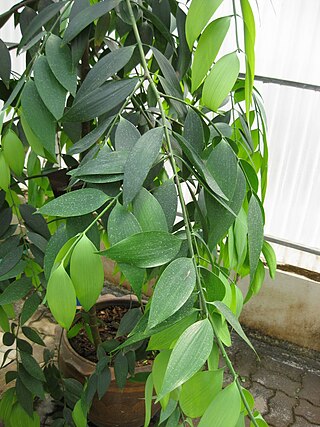
Nageia wallichiana is a species of conifer in the family Podocarpaceae. It is a tree 10–54 m high, found in Brunei, Cambodia, China, India, Indonesia, Laos, Malaysia, Myanmar, Thailand, and Vietnam. Nageia wallichiana is the most widely distributed species among the seven species in the genus Nageia. If the land areas of China and Japan are excluded, its distribution nearly coincides with that of the genus and includes both the western outliers in India and the easternmost part on Normanby Island. It is one of the most extensive conifer ranges recognized and is similar to Dacrycarpus imbricatus and Podocarpus neriifolius.
Myrcianthes oreophila is a species of tree in the family Myrtaceae. It is native to Peru and also probably Bolivia.
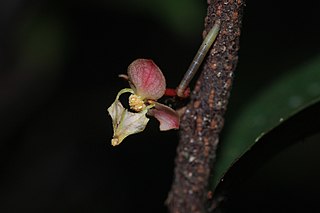
Orophea thomsonii or Thomson's Turret Flower is a species of shrub or small tree in the Annonaceae family. It is native to Kerala and Tamil Nadu in India and endemic to the Western Ghats mountain range.

Palaquium ravii is a species of tree in the family Sapotaceae. It is endemic to the Western Ghats mountains and native to Kerala and Tamil Nadu in India.

Phyllanthus anamalayanus is a species of plant in the family Phyllanthaceae. It is endemic to the Anamalai Hills in Coimbatore district in the state of Tamil Nadu, India. The species is a shrub or small tree occurring in the understorey of mid-elevation tropical wet evergreen forests in the Anamalai Hills, and is endemic to the Western Ghats. It is threatened by habitat loss.

Syzygium densiflorum is a species of evergreen tree in the family Myrtaceae. It is endemic to the Western Ghats mountains, India. The species is categorised as Vulnerable in the IUCN Red List.

Vateria indica, the white dammar, is a species of tree in the family Dipterocarpaceae. It is endemic to the Western Ghats mountains in India. It is threatened by habitat loss. It is a large canopy or emergent tree frequent in tropical wet evergreen forests of the low and mid-elevations.
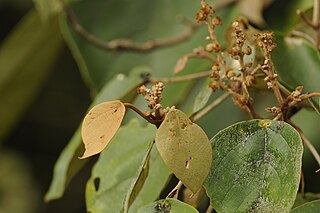
Mallotus tetracoccus, also known as the rusty kamala, is a species of flowering plant in the family Euphorbiaceae. It is a tree species found in parts of south Asia, typically occurring in the edges of tropical wet evergreen and semi-evergreen forests.
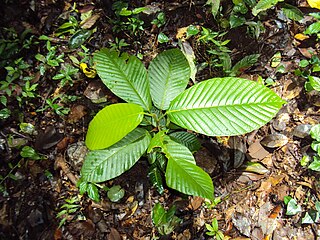
Dipterocarpus bourdillonii is a species of large tree in the family Dipterocarpaceae endemic to the Western Ghats principally in the state of Kerala in India. It is a Critically Endangered species according to the IUCN Red List of Threatened Species. It is a characteristic tree of the low-elevation tropical wet evergreen rainforests in the Western Ghats.

Bhesa indica is a flowering plant tree species in the Centroplacaceae family. It is distributed along the tropical wet evergreen forests of the Western Ghats of India. It is considered synonymous with Bhesa paniculata by some authors.

Palaquium ellipticum is a tree in the family Sapotaceae. This is a common canopy tree in low and medium elevation evergreen forests up to 1500 m. This species is endemic to the Western Ghats.

Myristica beddomei is a species of tree in the family Myristicaceae. It is endemic to the Western Ghats, India, where it is frequent in the mid-elevation wet evergreen forests and an important food tree of hornbills. The species has been earlier misidentified in regional floras and herbarium specimens as Myristica dactyloides Gaertn., the latter occurring only in Sri Lanka.

Cryptocarya anamalayana is a rare rainforest tree endemic to the southern Western Ghats, India. The specific epithet of the name refers to the Anamalai Hills, a major area of its distribution. The species considered endangered under the IUCN Red List of Threatened Species.

Diospyros paniculata, or the panicle-flowered ebony, is a species of tree in the ebony family. Endemic to the Western Ghats area of India and parts of Bangladesh, the species is currently listed as Vulnerable in the IUCN Red List.

Drypetes wightii is an evergreen tree species endemic to the Western Ghats, India. The species is considered Vulnerable under the IUCN Redlist of Threatened Species.
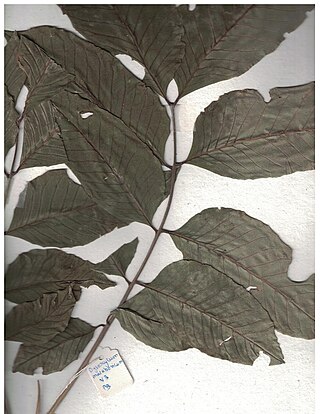
Dysoxylum malabaricum, or white cedar, is a tree species endemic to the Western Ghats, India. The species is considered Endangered under the IUCN Red List of Threatened Species.


























